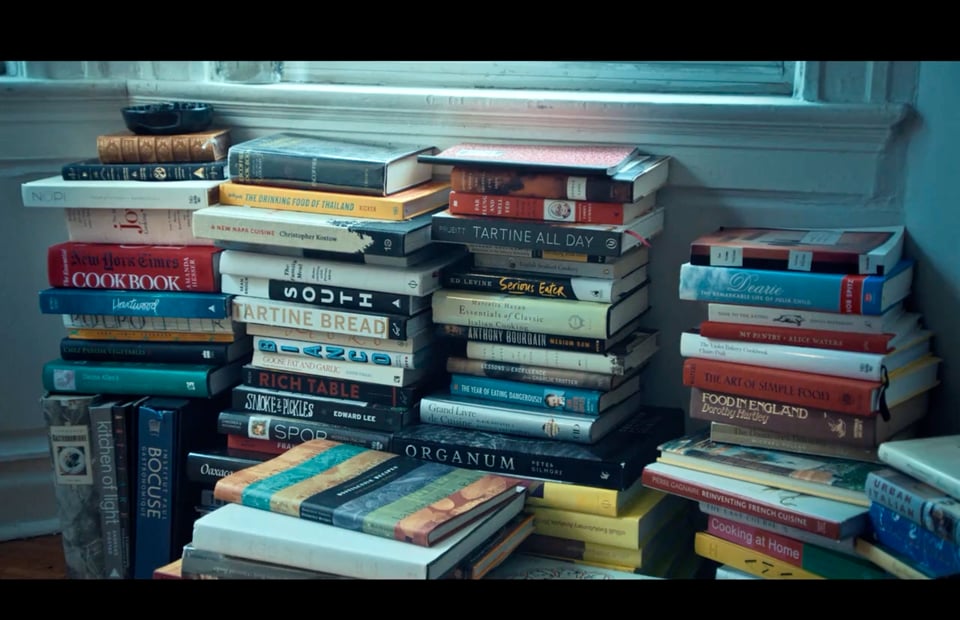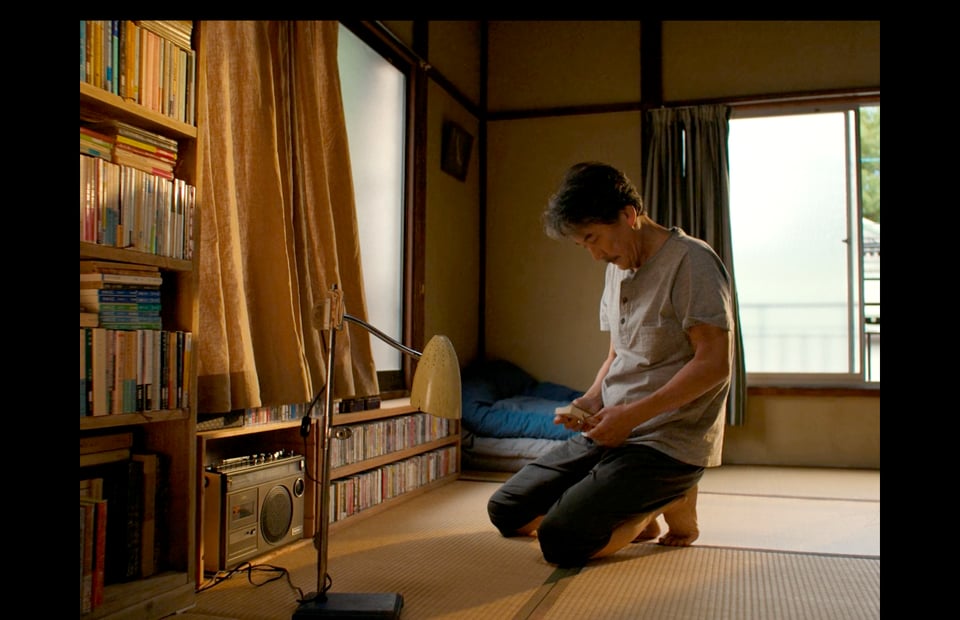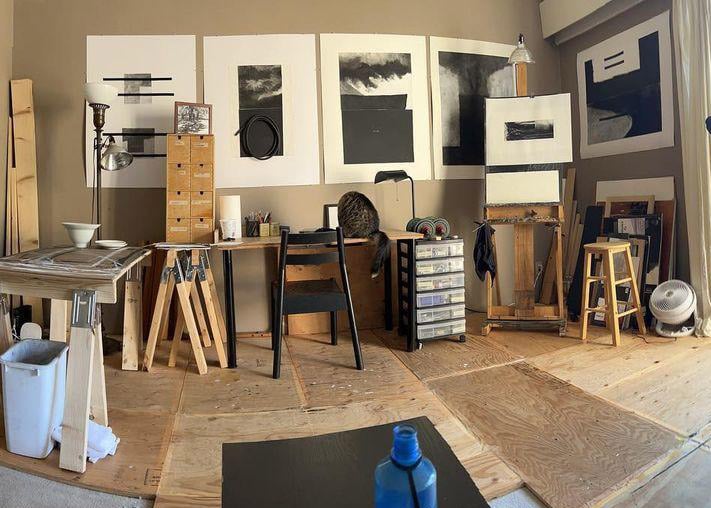Transmission 04 | 09.15.24
Reflections on summer adventures, loss, and the creative space that fuels our art.
Is Summer Over?
It’s been a whirlwind of a summer – adventure, misadventure, life! Longer than I hoped between transmissions, but here we are.
Last weekend, Tristesse, a beautiful group of friends, and I said goodbye to our longtime friend, neighbour, and fellow artist Derek Simons. Derek died suddenly and unexpectedly in June, and it’s been heartbreaking for so many reasons. Chief among them is that he was simply a delightful human. Having just entered his seventies, he was on a brave and inspiring trajectory with his work, despite battling Parkinson’s. He’s top of mind as I write this, and his presence is woven through many of the ideas I’m sharing here.
Unpacking Our Libraries
Back at the end of June, just before I began a summer fast from episodic television1, we binged the latest season of The Bear. I won’t dig into that whole show here, but one thing I love about that series is the part books play as a detail2.

Bookshelves and record collections3 are one of my little cinematic obsessions—I love how they add depth to a character. After words and actions, what someone surrounds themselves with gives us a richer sense of who they are. This can start with how they dress, but—if the screenplay allows—seeing their home provides even more insight. If we’re really lucky (and they’re readers), we get to peep their books.
Paterson is another example. There’s only one shot of Paterson’s small bookshelf in his writing space, but it’s packed tight with very intentional selections. Oh, you know I’m screen-grabbing that shot to read the smallest of the spines. I’m curious what it says about the character (and by extension, the director) but I’m also digging around for leads: books I’ve never heard of or ones that need to be budged up in my to-read queue.

Paterson reminds me of its natural cinematic sibling, Wim Wenders’ Perfect Days4. We don’t get a close-up of Hirayama’s bookshelves, but it’s clear that reading is central to how he’s designed his life. Throughout the film, we catch glimpses of the books he’s selecting. Specific details like this become footnotes for a character, even when they aren’t mentioned in the script.

Books, music, and other collections are revealing, intimate things. Derek had an extensive and beloved library, and at his celebration of life, his daughter invited us to make a selection if we felt drawn to any of them. I loved seeing these artifacts—extensions of his mind and curiosities. I chose Josef Albers’ Interaction of Color and a complete Rimbaud collection, both of which I’ll treasure.

When we visited Wayne Ngan’s iconic studio on Hornby Island in July, his family offered books from his studio for a small fee. Tristesse walked away with a handful that will enrich her practice both in the studio and her classroom. There’s something special about knowledge and inspiration passing through these physical artifacts—items that have seen things, been places—and the notion of one artist’s studio DNA becoming part of another’s.
Studio as Instrument
The concept of the studio as an instrument, popularized by Brian Eno, is well-known in music, but I’ve heard less about it in relation to other creative fields. For an artist, the studio is not just where things happen, I would argue that to an extent, it’s how things happen.
It can take any form or size—a kitchen table, a closet, a garage or even exist in the confines of a device—it’s whatever we’ve got. This studio environment provides a set of conditions and each artist may tune and retune it according to the work they’re doing, materials, personal quirks and preferences. Sometimes the space’s limitations end up defining characteristics of the work—compact or expansive work, tidy dry work or messy wet work.
In the last two places he lived, Derek completely converted his living room into a studio. I saw this as a radical commitment to his practice and just cool as hell. At the event last weekend it was noted how much creative space meant to him, and his enthusiasm for optimizing these spaces.
“This reminds me of my childhood fascination with pictures of artists like Picasso or Pollock in their studios. I wonder how many people are launched into a life in the arts not just by the work of earlier artists, but by where they did it—the powerful allure of the creative space. Pictured here is my current studio, recently reconfigured to make it, like, 50% more functional.”

At the intersection of creative spaces and my interest in artists producing work later in life5 is Joshua Charow’s documentation of New York’s ‘Loft Law’6 and the last artists protected by it. His book and short films on the subject are a delight. Imagine transforming and tuning a creative space for half a century or more!

That’s it for now! Just a reminder that there are a few weeks left to catch my work at Propellor, which wraps up on October 10. They’ll be having an open studio on September 21 and 22 as part of Design Week Vancouver.
Tristesse and I will be participating in Culture Crawl this November, and I’ll have more details on that soon. I’ve also re-added a short-form blog for quick news, music playlists, and other shares via my site—worth checking in on too.
✌️D
👉 If this is was forwarded to you and you’re interested in more…
I decided to take a break from episodic TV for the summer in favour of watching more films. I don’t watch a ton of episodic shows, but when I do, I often feel frustrated being tied to stories that might end next month—or in five years—depending on market demands rather than the story’s natural arc. I’m becoming more inclined to pop in and immerse myself in a contained world, knowing I’ll be out the other side in a known number of hours. It was great, and I’ll likely keep on trucking through the fall. ↩
In the previous season, I was delighted to spot Ayo Edebiri’s Sydney reading Will Guidara’s Unreasonable Hospitality ↩
Dust and Grooves has been documenting the majesty and eccentricity of the record collection for over fifteen years with their interviews and beautiful books. ↩
After watching Perfect Days early this year I was immediately taken with the notion that it was the perfect pairing with Jarmusch’s Paterson. Both centre around blue collar characters intertwining work and their creative pursuits and each film operates in a shared film language that is mediative – elevating and celebrating the everyday. ↩
Many years ago, I had this little blog called 40 Over 70. The idea was to share short biographies of creative people (artists of all sorts) that were in their seventies and beyond and were not only still creating work, but (I would argue) doing work that was not possible by someone half their age. I had to drop the project after a year or so just due to a lack of time but I’m heartened both by the number of people I continue to see that fit this criteria and that others share an interest in this area – for example there is now a podcast called 70 Over 70. ↩
Article 7-C of the New York Multiple Dwelling Law, commonly known as the 1982 Loft Law, was designed to protect the residential tenants of certain former commercial buildings in New York City from substandard conditions, eviction, and unfair rent increases. More here ↩
Add a comment: